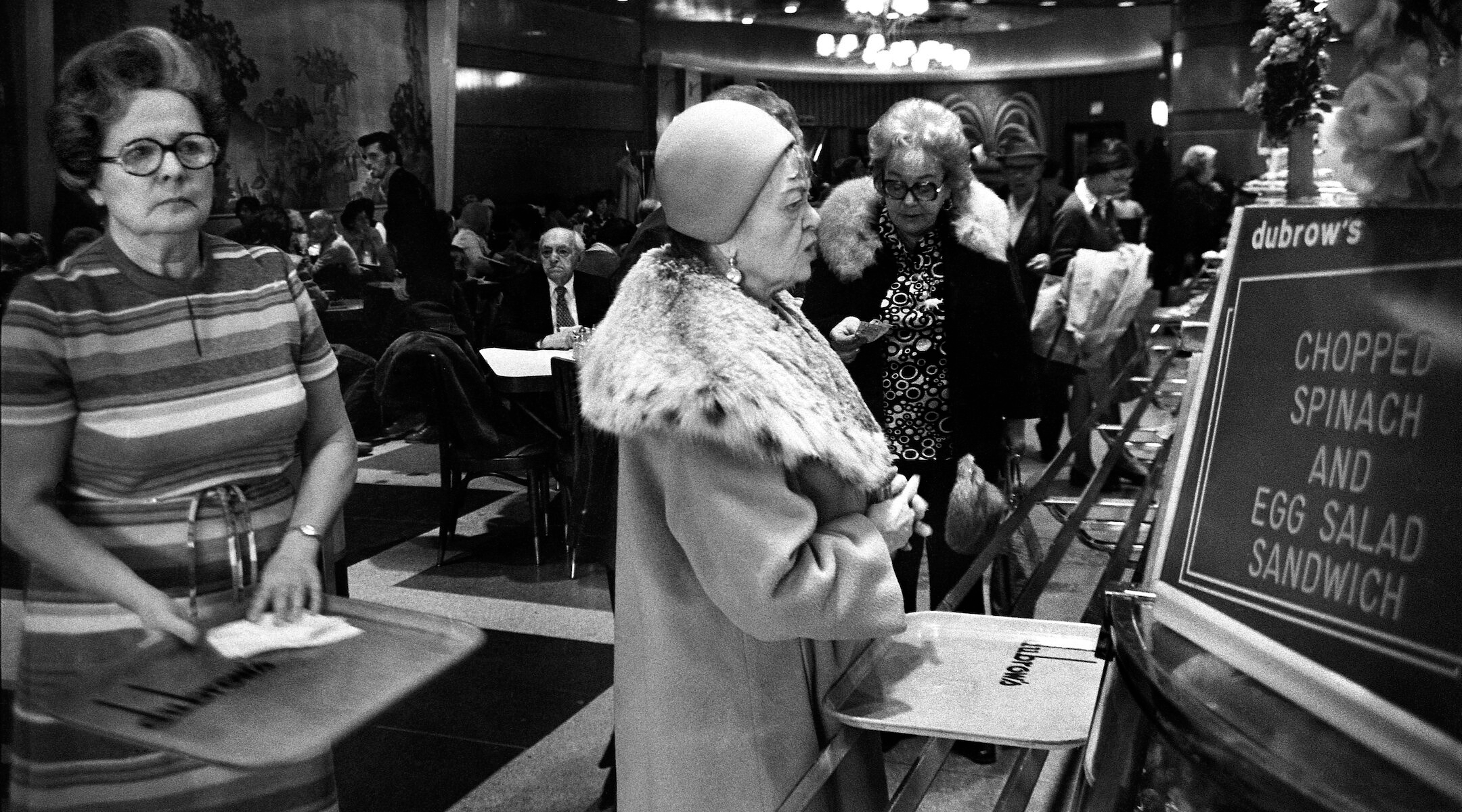(New York Jewish Week) – Back in 1975, Marcia Bricker Halperin had just graduated from Brooklyn College with the dream of becoming a professional photographer when she stepped into the Flatbush outpost of Dubrow’s, a cafeteria-style restaurant, for a warm cup of coffee.
It was there that inspiration hit. “I was wonderstruck,” Halperin writes in the introduction to her new book of photographs, “Kibbitz & Nosh: When We All Met at Dubrow’s Cafeteria,” describing the “cavernous” space with mirrored walls and a mosaic fountain. “It was the most idiosyncratic room I had ever seen.”
“I sensed it was a vanishing world on its last legs, and that impelled me to document it,” she continues. “On many visits, the tables were empty, sans a painterly still life of condiment bottles and jars in the morning light. I also perceived cafeterias as places that embodied a secular Jewish culture, something that was of great interest to me.”
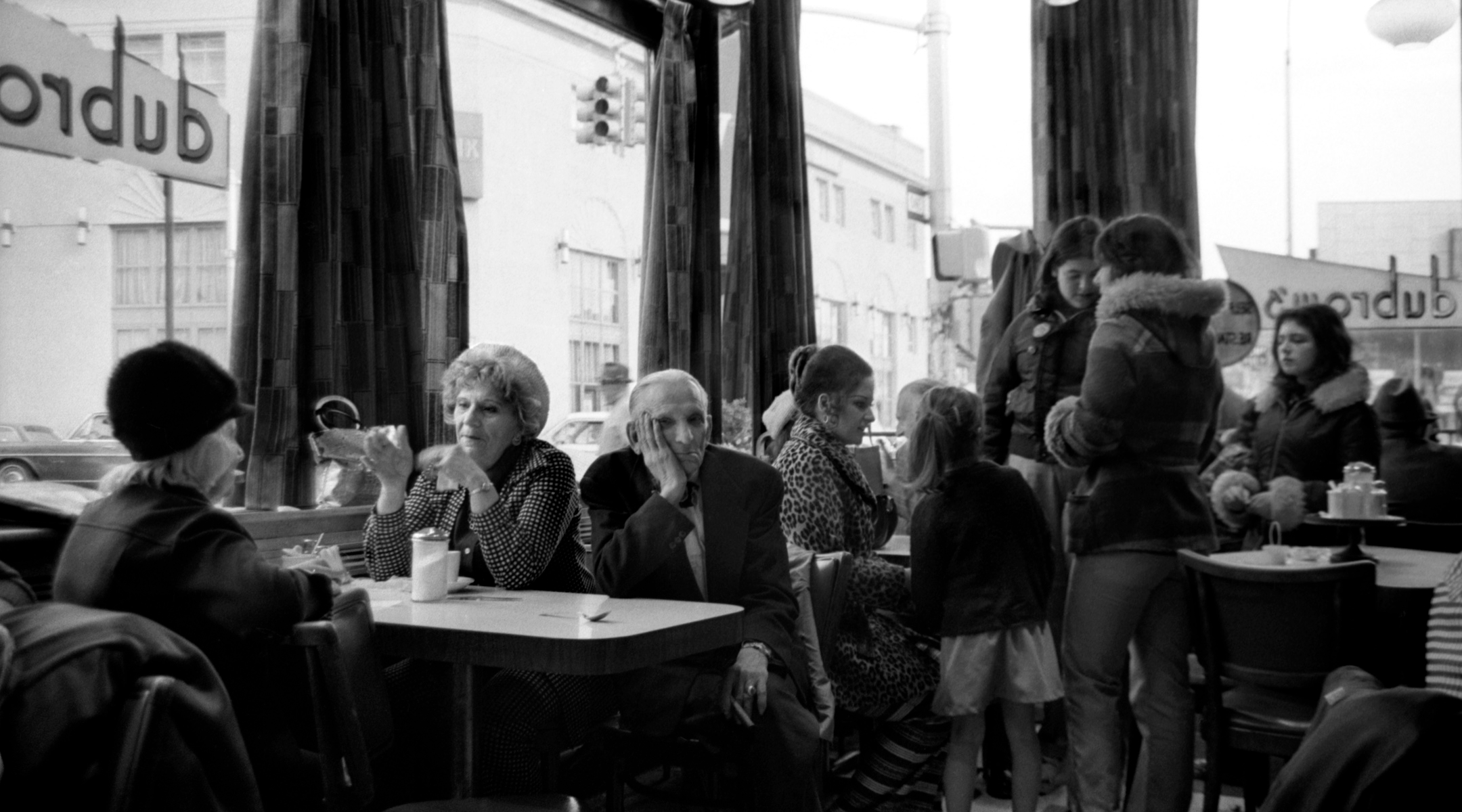
“I attended a lecture by Isaac Bashevis Singer, who was billed as an “Outstanding Anglo -Yiddish” author, at the Brooklyn Jewish Center on Eastern Parkway in Crown Heights,” Bricker Halperin writes in the introduction. “I adored his short stories, many of which were set in cafeterias, and I regret never finding the nerve that day to tell him about my own cafeterianiks.” (Marcia Bricker Halperin)
Halperin was prescient: She started photographing these once-ubiquitous eateries one decade before the final Dubrow’s location in the Garment District would close in 1985. The chain’s first location was founded in 1929 on the Lower East Side by Benjamin Dubrow, a Jewish immigrant from Minsk. By the mid-twentieth century, the family-owned company expanded throughout Brooklyn, Manhattan and Miami Beach, with ownership passing to the second generation, and then to the third. In Dubrow’s prime, a stop at one of the cafeterias was practically required for politicians such as John F. Kennedy and Jimmy Carter.
Nearly 50 years after her first visit, Halperin’s new book is a tribute to this now-defunct New York City cafeteria culture and the characters she met during the five years she regularly photographed there. The compelling 152-page book features her original black-and-white photos along with essays from Pulitzer Prize–winning playwright Donald Margulies and Jewish American historian Deborah Dash Moore.
“Although Jews were not the only ones to patronize cafeterias, they preferred them as inexpensive places to hang out to bars, which often attracted an Irish immigrant or working-class clientele,” Moore writes in her essay, titled “See You at Dubrow’s.” “By the 1930s, cafeterias were part of the fabric of Jewish neighborhood life in New York City, a welcome alternative for socializing to cramped apartments, street corners, or candy stores.”
Now living in Park Slope and retired from a career as a special education teacher, Halperin talked with the New York Jewish Week about the city’s lost cafeteria culture and what inspired her to capture it with her camera.
This interview has been edited for length and clarity.
New York Jewish Week: You took these photos nearly 50 years ago. What made you decide to publish them now?
Marcia Bricker Halperin: In the 1970s, there was such good feedback on the work. I was given a show, I was collected by a few people, I had a photo in The New York Times. People wrote me letters in the mail: “Ms. Bricker, I’m interested in buying one of your photos.” At the time, I was in a project called the CETA artists project, a federally funded arts project in the ’70s where I was paid to be a photographer. It was very much like the [Depression-era] WPA project, but one of the great differences with the CETA project was anything you shot, you owned.
So I continued photographing changing New York during those years — some of it by assignment for nonprofit organizations that I worked with, like the Jewish Museum and an organization in Brighton Beach that was resettling the Soviet Jews that were arriving in the ’70s. They wanted photographs to help both the Soviet Jews understand American life and the old Jewish population in Brighton Beach understand Russian life. What a great opportunity!
I was going to be an artist and I did adjunct teaching and different things to make it work. I kind of fell into teaching high school photography and then, from there, I fell into teaching special education — that took over. Thirty-five years later, I retired from teaching. The day after I retired, I took out my negatives and my photography stuff and bought a scanner and all kinds of printers and things.
So, I was a photographer once upon a time and then taught for many years and, overnight, I became one once again.
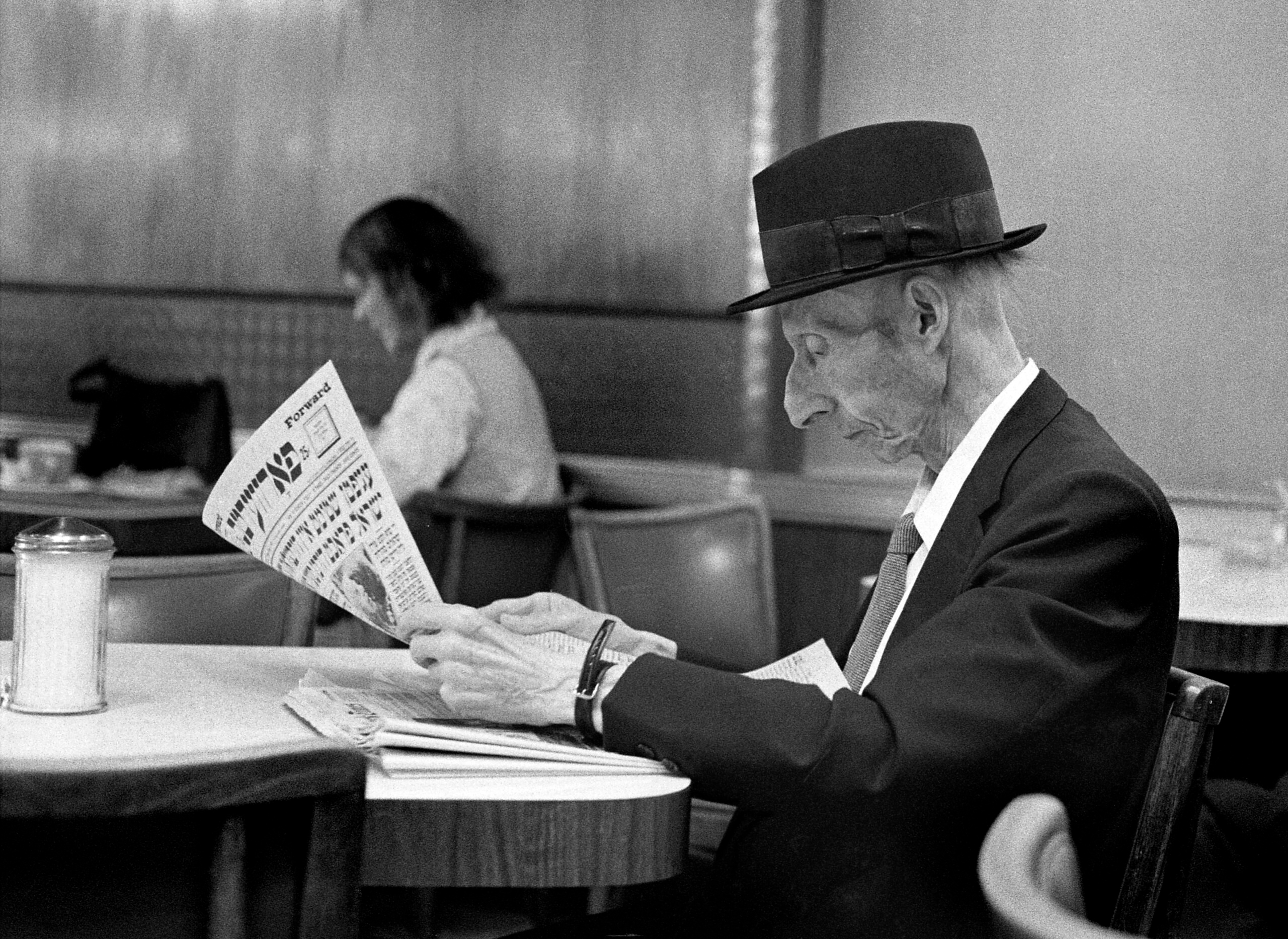
A man reads the Forvertz newspaper in Yiddish. (Marcia Bricker Halperin)
How did it feel to see these photos again? Had you developed any of them before?
Yes, I printed quite a few of them then. I worked as a darkroom lab technician, so I had an opportunity in the ’70s to do a lot of silver gelatin prints. I would bring in a thick envelope of the imperfect prints to the cafeteria and at that point, everybody knew me. I gave out portraits to people. If I hadn’t shot them, they would gather around me asking: “Do you have my picture? Did you print it?” Especially the staff — there was a very international cohort of people working there and they all wanted pictures to send home to their families.
After that, the pictures lay fallow for all these years. I protected them and stored them very carefully. When I had the opportunity to come back and put together a sample book, I started looking through the negatives and I said, “Oh, my God, I don’t remember that picture.” It was a time warp to see some of these photos taken in the 1970s. In Manhattan, the ’60s had happened, but Flatbush in Brooklyn was the “Old Country.” It hung onto the past for a while and some women dressed like they were still in the 1950s.
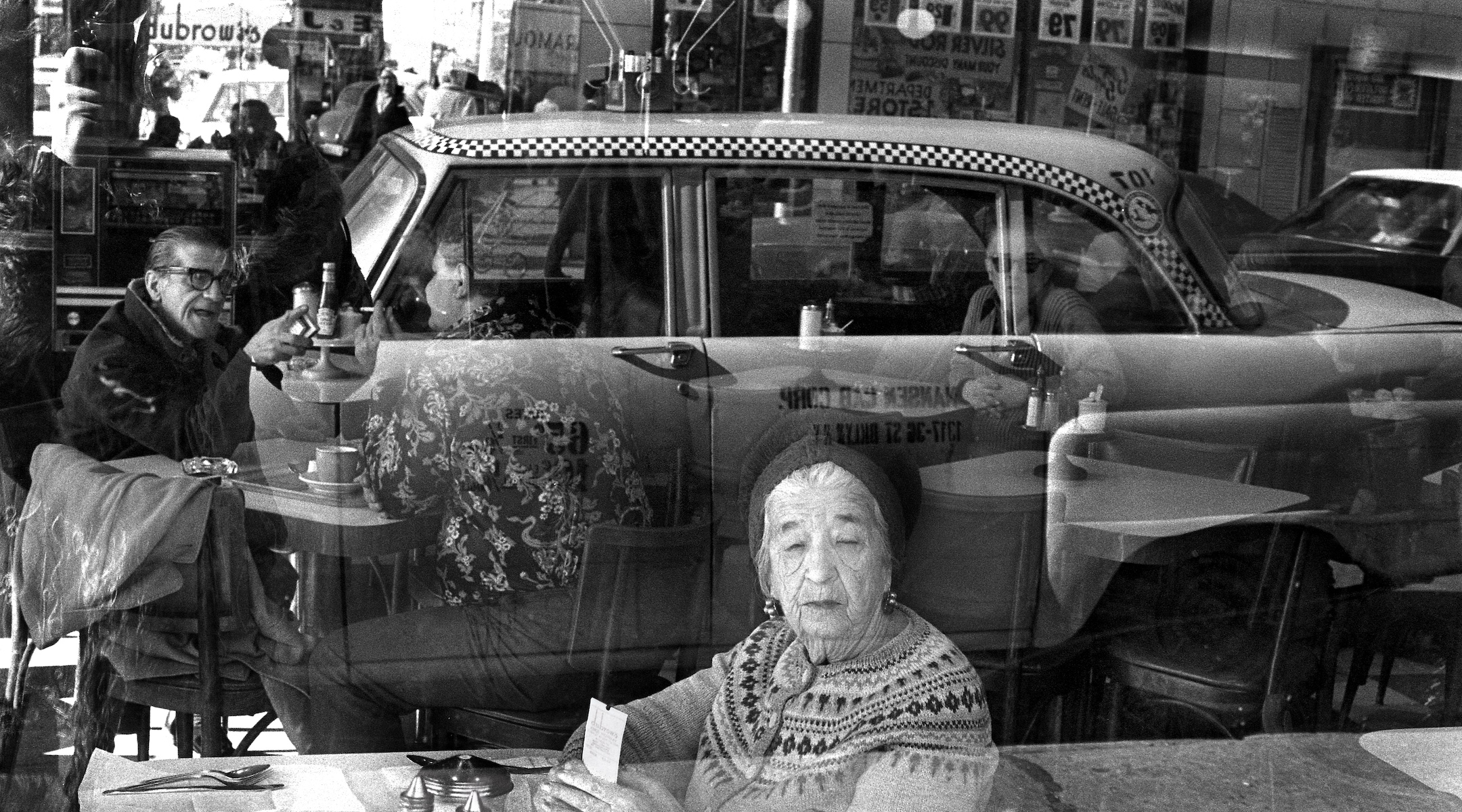
Dubrow’s Cafeteria, Kings’s Highway 1975. The photographer appears in the top left corner. (Marcia Bricker Halperin)
Dubrow’s closed just ten years after you started shooting there. Could you feel at the time that cafeteria culture was ending?
I kept a journal at the time. When I went back 42 years later to look at it, I had written: “One day I’m going to show up here and this is going to be closed.”
There were other cafeterias in Manhattan and the Bronx and they had all closed. I’ve collected like every article ever written about cafeterias, and there’s one from 1973: “Are cafeterias going to be gone?” So it was fairly well known that this was a vanishing kind of establishment in New York. The automats ceased having the little boxes, Burger King bought them out, they tried to modernize and it got pretty sad. Sometimes during the day, the huge cafeteria would be empty and people would say, “This business can’t survive.” So I knew I was photographing in the vein of needing to document the things that are there and will be gone. It was one of the things that propelled me to get out there and photograph.
Today, things are different. There’s food courts and wonderful little coffee places. There are many businesses, especially here in Brooklyn, trying to perpetuate “grandmother foods” and there are restaurants that are serving “reinvented Jewish-style foods.” So there are some continuations, but in terms of the huge, opulent cafeteria spaces — grand professional murals, intricate woodworking, food with a crazy amount of preparation, 300 items, 30 different cakes — no restaurant could possibly survive like that. The only thing that still exists are my photos of them.
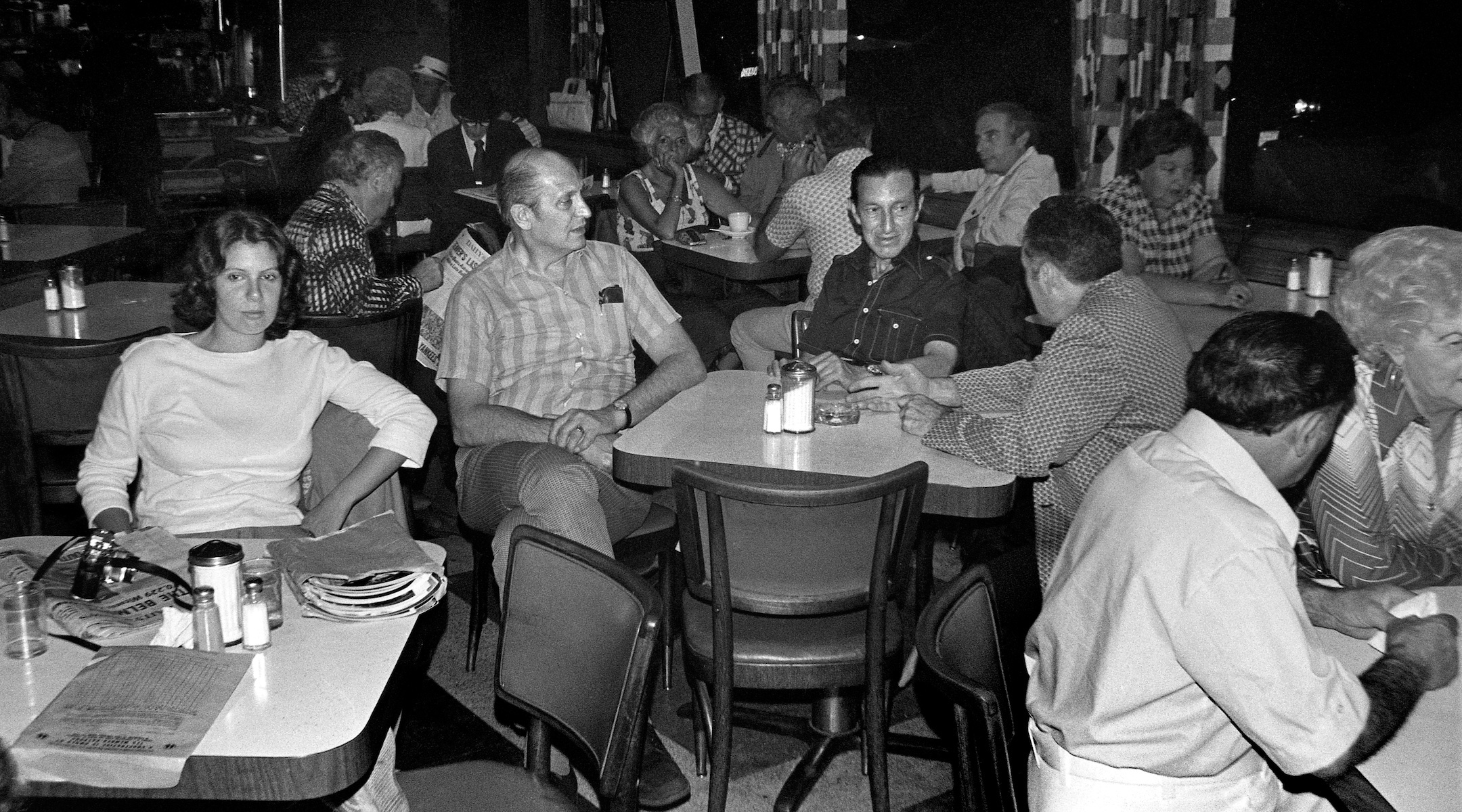
Men and women converse around empty tables at Dubrow’s on Kings Highway. Marcia Bricker Halperin sits on the left with her camera on the table. (David Stark)
What was the Jewish culture of Dubrow’s and Flatbush like at the time?
Growing up, we went to a little old “Conservadox” synagogue. We were the kind of family where my mother kept a kosher kitchen at home, but on Sunday nights we’d go out to the Chinese restaurant. Dubrow’s menu was “Jewish-style” but it was also a place you could go out and have your first shrimp salad sandwich, which became their most popular food. They were famous for shrimp salad!
These cafeterias were all started by Jewish immigrants. But they were democratic for everyone — there was ham on the menu, shrimp. You could choose whether to have just meat or have a meat meal and then have a cream pie for dessert. That was your choice. With cafeteria-style, like religion, you pick and choose what you want and what you want to observe.
When I would go there, all the older people would ask: “Are you Jewish? You don’t look Jewish.” I’d say,“I’m Jewish. I know a few words of Yiddish, my parents speak Yiddish at home.” They would be satisfied with that. There was this sense that it was a club a little bit, it was a Jewish establishment. Not that everybody wasn’t welcome, and everybody socialized with everyone else.
Socializing was a big thing there, not necessarily eating. Many of my pictures are people sitting around — sometimes it’s a coffee cup on the table, most of the time the table is empty. They were there to meet their friends and talk. Some people said it replaced the synagogues. The old men would go to Dubrow’s and have a cup of coffee with their friends in the morning and gossip and talk.
“Kibbitz & Nosh: When We All Met at Dubrow’s Cafeteria” will be published on May 15, 2023. The photos are on exhibit at the Edward Hopper House in Nyack, New York through June 25.
The New York Jewish Week brings you the stories behind the headlines, keeping you connected to Jewish life in New York. Help sustain the reporting you trust by donating today.
